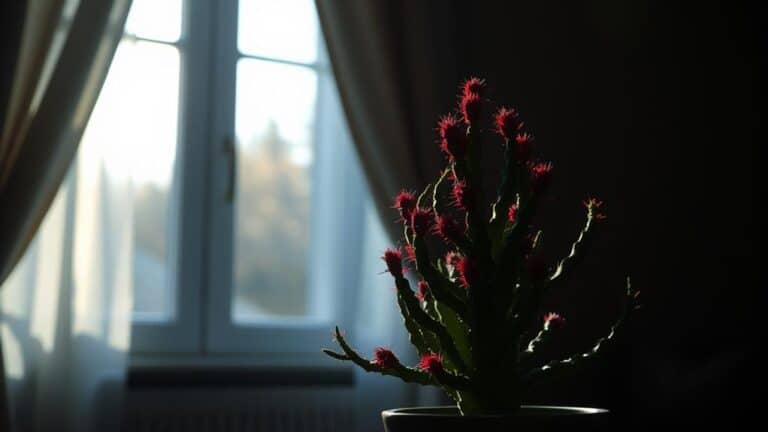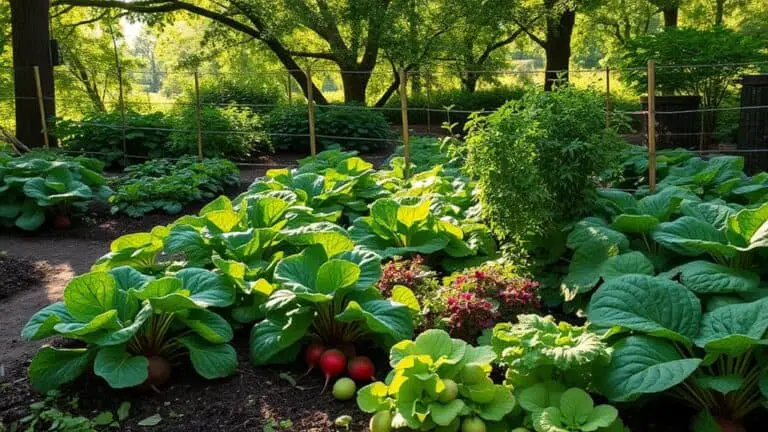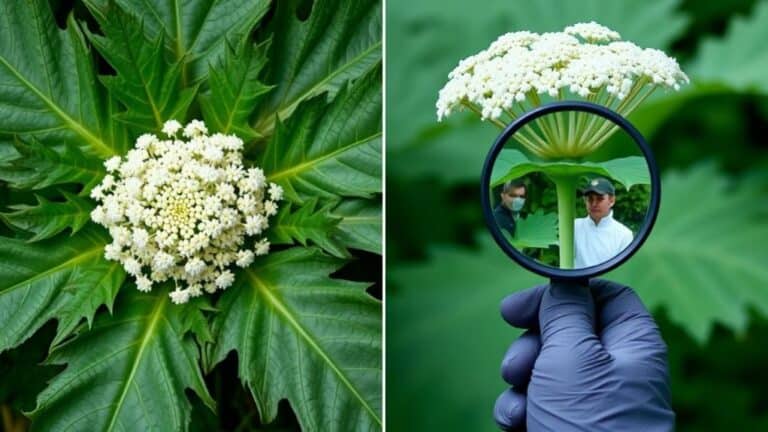Sign That Your Fruit Tree Is In Heat Stress
I recently noticed some troubling signs in my fruit tree that might indicate it's under heat stress. The leaves started wilting and the edges turned dry and crispy. What really caught my attention was the premature leaf drop, which got me thinking about moisture deficiency and excessive water loss. If you're seeing similar symptoms, it's crucial to take action before things get worse. But that's not all—there are other, perhaps less obvious signs that your tree is struggling. Let's explore those signs and discuss how you can help your tree recover from the extreme heat.
Leaf Wilting
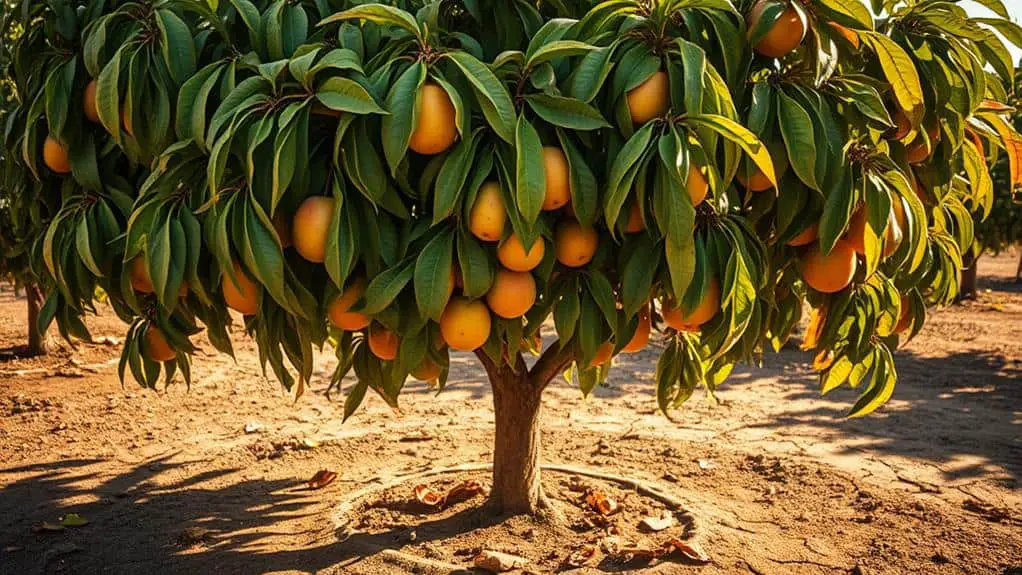
Leaf wilting in fruit trees is a clear sign that they're struggling with moisture deficiency, often due to excessive heat or drought. When trees experience heat stress, they lose more water through transpiration than they can absorb from the soil, causing noticeable wilting. You might see leaves and stems drooping, but if temperatures cool down and you provide enough water, they can recover.
Prolonged wilting, however, can cause permanent damage to your tree, affecting its health and fruit production. It's essential to keep an eye out for wilting during heat waves.
Dry Leaf Edges
Often, dry leaf edges on fruit trees signal that they're undergoing heat stress. This usually happens because the leaves lose too much water during hot weather, causing dehydration.
You might notice the outer edges of the leaves drying out while the inner parts stay green. Here's what to look for:
- Excessive water loss: High temperatures make leaves lose moisture quickly.
- Dehydration: The tree can't keep up with the water demand.
- Energy redirection: The tree focuses on conserving resources, leading to signs like wilting.
- Environmental factors: Dry or windy conditions can worsen the problem.
- Regular monitoring: Keep an eye on your trees and make sure they get enough moisture.
Leaf Scorch
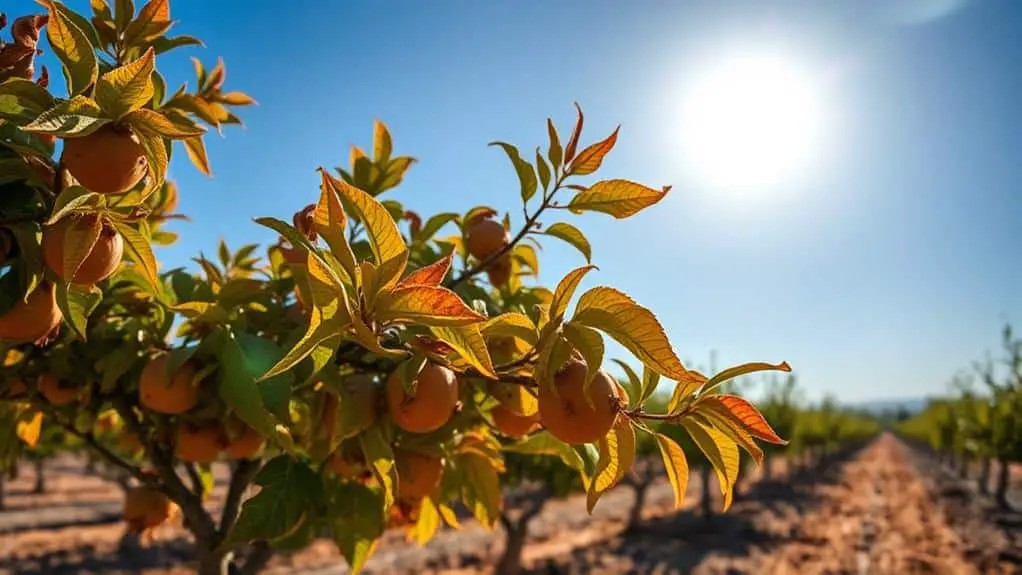
Let's talk about leaf scorch and how to spot it.
You'll notice browning or drying at the edges and tips of leaves, a clear sign your tree is stressed from too much heat and not enough water.
To prevent this damage, keep an eye on your trees, especially during hot spells, and make sure they're getting enough water and some shade.
Identifying Scorched Leaves
When you notice the edges of your fruit tree's leaves turning brown or curling, it's a clear sign of leaf scorch. This happens due to heat stress and moisture loss. Scorched leaves often appear dry and crispy, and they may fall off prematurely. This is the tree's way of conserving resources.
Here are some key indicators of leaf scorch:
- Browning or curling edges: The first sign you'll see.
- Dry, crispy texture: Affected leaves feel brittle.
- Premature leaf drop: Leaves fall off earlier than usual.
- Vulnerability in young trees: Young and less heat-tolerant varieties are more prone.
- Overall health decline: Signals potential for pest and disease issues.
Monitoring these signs helps you understand your tree's health and take action.
Preventing Leaf Damage
Preventing leaf scorch in fruit trees is essential to maintaining their health and productivity. Leaf scorch, seen as browning edges, happens when trees lose water due to heat stress.
To combat this, keep soil moisture levels high by deep watering. This guarantees the roots get water even during dry spells. Mulch around the tree base helps retain soil moisture and keeps temperatures stable.
For immediate relief, use shade cloth or move potted trees to shadier spots to cut down on direct sunlight. Regularly check for signs of heat stress, like wilting or early leaf drop.
Early intervention gives you a chance to adjust care and prevent further damage. Your trees will thank you for the extra attention!
Blossom Drop
Blossom drop in fruit trees is often a direct response to heat stress, where the tree sheds its flowers to conserve energy and resources during extreme temperatures.
When your tree experiences heat stress, it prioritizes survival over reproduction. High temperatures, especially coupled with a lack of water, can lead to premature blossom drop.
Here are some key points to help you understand and manage this issue:
- Heat stress: High temperatures cause trees to shed blossoms.
- Water: Insufficient water during heat waves worsens blossom drop.
- Night temperatures: Warm nights add to the stress, leading to more flower loss.
- Sensitive varieties: Some fruit tree types are more prone to blossom drop.
- Monitoring: Keep an eye on environmental conditions and guarantee adequate watering.
Fruit Sunscald
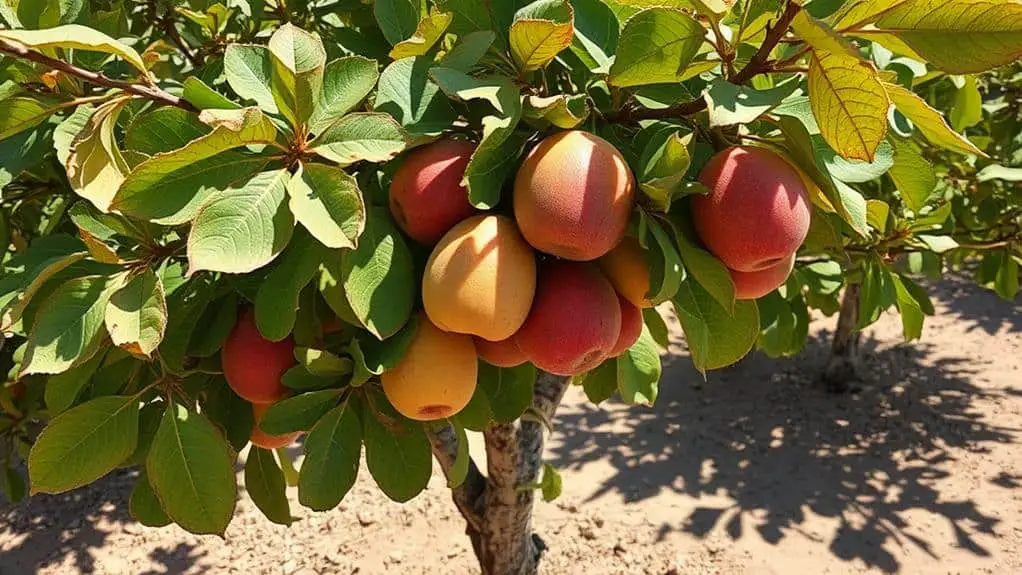
During scorching summer days, fruit trees can suffer from a condition known as sunscald, where the intense heat and direct sunlight damage the fruit's surface.
Fruit sunscald occurs when high temperatures cause the fruit to become discolored, often looking bleached or brown. This typically affects the exposed sides of fruits, especially on south-facing canopies that get the most sun.
Young trees are particularly vulnerable due to their inadequate leaf coverage, making them more susceptible to heat stress. Symptoms include cracking and scarring, which can attract pests and diseases.
To manage this, try providing shade with cloth or natural barriers and keep your trees well-watered. These steps help reduce overall stress and protect your fruit from sunscald.
Premature Leaf Drop
Premature leaf drop can strike fruit trees hard during intense heat waves, causing them to shed leaves early as a desperate survival mechanism. It's their way of conserving resources and reducing water loss.
You might notice:
- Wilting leaves
- Scorched leaf edges
- Dropped leaves around the tree base
- Reduced canopy density
- Young trees struggling more
High temperatures and drought make this worse, as trees focus on saving the remaining foliage and fruits.
Young trees are particularly at risk since their roots aren't fully developed to reach deeper moisture. Monitoring your trees during heat waves is essential.
Excessive premature leaf drop can lead to reduced fruit yield and overall tree health. Keep an eye on your trees, and you'll help them stay strong.
Reduced New Growth

A telltale sign of heat stress in fruit trees is reduced new growth, where you'll notice stunted leaf and branch development during the peak growing seasons.
When trees are under heat stress, they often shift their energy towards survival. This means they won't focus as much on producing new shoots or foliage.
Normally, healthy fruit trees should have lots of new growth when conditions are good. If your tree is struggling, you might see little to no extension in its branches.
This lack of new growth can also lead to lower fruit yield because the tree is using its resources to cope with the heat instead of making fruit.
Keep an eye on this to help your tree thrive.
Branch Dieback
Branch dieback is a telltale sign that your fruit tree might be struggling with heat stress, often due to extreme temperatures making it hard for the tree to take up enough water and nutrients.
You might notice branches wilting, changing color, or failing to grow new leaves, which means your tree is trying to survive by focusing resources on its most critical parts.
To protect your trees, make sure they get deep, regular watering and consider mulching around the base to help retain moisture and keep roots cool.
Causes of Dieback
Often, branch dieback in fruit trees is a direct result of prolonged heat stress. When temperatures soar, trees struggle with water uptake, leading to the loss of leaves and premature fruit drop.
High heat can cause vascular dysfunction, making it hard for trees to transport water and nutrients. This, in turn, leads to branch dieback. Symptoms include wilting, discoloration, and dead branches.
Additionally, heat-stressed trees become more vulnerable to pests and diseases, which can worsen the problem.
Here are some factors that can exacerbate branch dieback during extreme heat:
- Drought conditions
- Poor soil quality
- Lack of proper irrigation
- Extreme heat events
- Pest and disease pressure
Understanding these causes can help you better care for your fruit trees.
Early Warning Signs
Prolonged heat stress doesn't just lead to dieback; it also presents early warning signs that can help you intervene before the damage becomes extensive. One of the first signs is branch dieback, especially in young trees. You'll notice this dieback on the south-facing sides, where the heat is the most intense. As the heat stress worsens, you might see premature leaf drop and slower growth, which increases the risk of branch dieback. Regularly monitoring your trees can catch these signs early. This allows you to adjust watering and provide shade, helping to save your tree from severe damage.
| Early Warning Signs | Impact on Tree |
|---|---|
| Branch Dieback | Loss of energy |
| South-facing Sides | Higher temperatures |
| Premature Leaf Drop | Moisture conservation |
| Reduced Growth | Increased vulnerability |
Protective Measures Needed
Addressing branch dieback in fruit trees under heat stress demands immediate and effective action.
When your tree shows signs of branch dieback, it's crucial to act quickly to protect it from further harm. Here are some practical steps you can take:
- Watering strategies: Deep watering helps roots grow stronger and access deeper soil moisture.
- Provide shade: Use shade cloth or plant companion shrubs to shield trees from intense sunlight.
- Mulch application: Spread mulch around the base to retain soil moisture and regulate temperature.
- Regular monitoring: Check for wilting leaves and dry wood to catch issues early.
- Prune affected branches: Remove dead or dying branches to prevent disease spread and encourage new growth.
Increased Pest Vulnerability
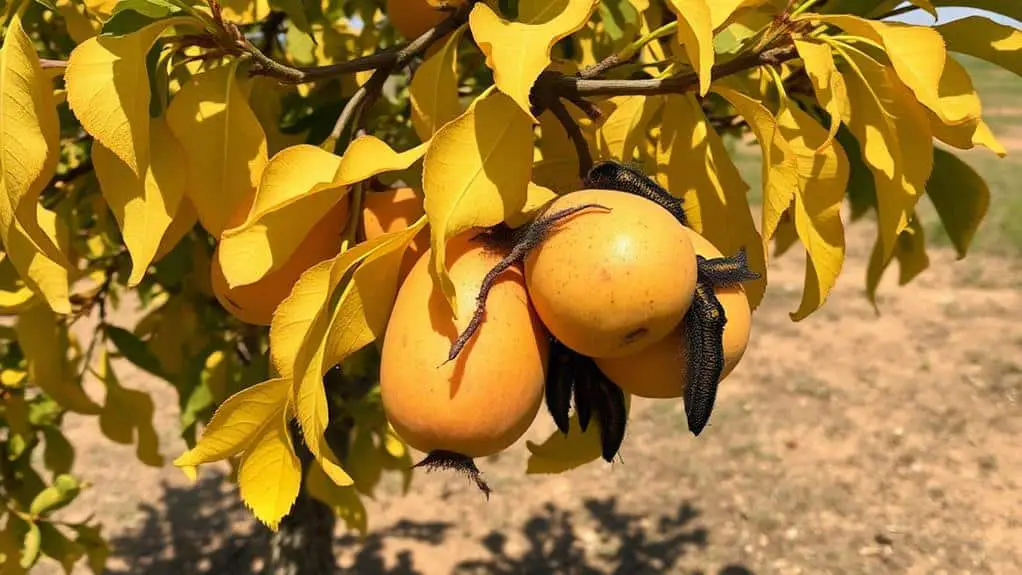
When fruit trees face heat stress, their weakened state makes them more vulnerable to pest infestations. Stressed trees often lack vigor and resilience, and high temperatures contribute to increased leaf wilting and damage. This attracts pests like aphids and spider mites, which thrive on weakened plants.
The physiological stress from excessive heat can cause the production of volatile compounds, potentially increasing pest infestations. Additionally, stressed trees may drop leaves prematurely, exposing them to more sunlight and further weakening their health.
Monitoring for signs of pests, such as changes in leaf color or texture, becomes essential during heat waves. If left unaddressed, stressed trees can experience rapid increases in pest populations, so stay vigilant and proactive.
Effective Watering Techniques
Let's talk about how to water your fruit trees effectively.
Deep, infrequent watering works best because it helps roots grow deeper and reduces water loss from evaporation.
Check the soil about 6 inches down to see if your tree needs more water, as sometimes the surface can be dry even when there's enough moisture below.
Deep Infrequent Watering
Deep, infrequent watering is essential for maintaining the health of fruit trees, especially during periods of heat stress.
By practicing deep watering, you encourage roots to grow deeper into the soil, which helps them access moisture and nutrients more effectively.
Here are some key points to keep in mind:
- Mature trees need around 50 gallons of water on hot days.
- Young trees require 5 to 15 gallons weekly.
- Focus on watering the soil around the roots, not the foliage.
- This method minimizes evaporation and maximizes absorption.
- Always monitor soil moisture about 6 inches below the surface.
Deep watering helps your fruit trees withstand heat stress, keeping them healthy and productive.
Soil Moisture Check
Checking soil moisture is essential for effective watering techniques, especially during heat stress. To check, dig about 6 inches deep near your fruit tree. If the soil feels dry at that depth, it's time to water. This helps prevent your tree from suffering heat stress.
Remember, mature fruit trees can need up to 50 gallons of water on hot days. Deep watering is better than frequent shallow watering because it encourages roots to grow deeper. This way, they access moisture more efficiently.
Adjust your watering schedule according to each tree's needs. Young trees might need 5 to 15 gallons weekly.
Also, keep an eye on your irrigation system to make sure it delivers the right amount of water, especially during heat waves.
Frequently Asked Questions
How Do You Know if a Tree Is Heat Stressed?
I know a tree is heat stressed by symptom identification: wilting leaves, scorched edges, and early leaf or fruit drop. Understanding heat stress causes helps me adjust watering and provide shade, vital tree care tips for recovery.
What Does a Heat Stressed Plant Look Like?
When I notice leaf discoloration, wilting branches, and fruit drop on my tree, I know it's heat-stressed. The leaves might be yellowing or browning, branches droop noticeably, and immature fruits often fall prematurely. It's distressing.
How Do You Revive a Heat Stressed Tree?
To revive a heat-stressed tree, I focus on watering techniques, ensuring 5 to 50 gallons per week. I apply mulch around the base and use shade solutions to protect it from direct sunlight, aiding its recovery.
How to Protect Fruit Trees From Extreme Heat?
To protect fruit trees from extreme heat, I use mulching techniques for moisture retention, effective irrigation methods like deep watering, and shade solutions such as cloths or relocating container trees. These steps help shield them from heat stress.
Conclusion
So, if you spot any of these signs of heat stress on your fruit tree, don't worry. You're now equipped with the knowledge to help it recover. Keep an eye on those leaves, blossoms, and fruits. Make sure to water effectively and provide shade if needed. Your tree will thank you for it! Remember, you've got this. With a little care and attention, your fruit tree will thrive even in tough conditions. Happy gardening!



